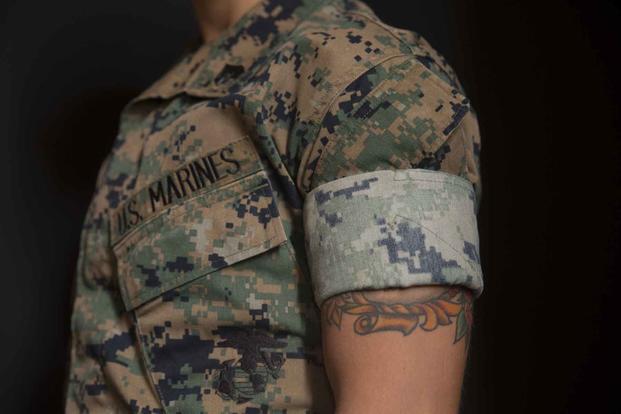Marine Corps commanders down to the battalion and squadron level are allowed to authorize troops to wear desert pattern uniforms or flame-resistant gear, also known as FROGs, amid an ongoing uniform shortage in the service, top leaders announced Thursday.
Gen. Eric Smith, the newly confirmed Marine Corps commandant, and Sgt. Maj. Carlos Ruiz, the service's top enlisted leader, formally acknowledged the shortage of woodland camouflage uniforms and announced the decision to allow flexibility on uniforms in a video message to Marines.
The shortage of the woodland Marine pattern, or MARPAT, uniforms that serve as the primary daily utility attire for troops across the service began plaguing military clothing outlets when the COVID-19 pandemic interrupted supply chains around the world and has yet to abate.
Read Next: Troops and Tattoos: A History in Ink
"I can't get cammies," Smith said in the video posted to Instagram Thursday. "That problem is going to stay with us until the fall of 2024 when the manufacturer can fill the backlog that has been created after COVID."
Until that logjam has been resolved, Marines are adapting by authorizing the wear of other uniforms.
"What we cannot have is a situation where a Marine is wearing unserviceable cammies, because that looks bad for the Corps," he said. "And we can't have a situation where that Marine is given a hard time about those unserviceable cammies."
The authorization does not mean that individual Marines can decide to wear a different uniform if they are having issues with serviceability or finding a uniform, according to Maj. John Parry, a spokesperson for Marine Corps Installations Command. That decision is up to the battalion or squadron commander, usually a lieutenant colonel.
"Marines should communicate with their chain of command if they are having serviceability issues to enable an appropriate authority to make a decision," Parry told Military.com over email.
In 2017, American Apparel Inc., a manufacturer out of Alabama, was awarded an over $48 million, firm-fixed-price contract for the Marine Corps' combat utility uniforms for the next five years.
"Nobody even knew the word 'COVID,'" Chuck Lambert, the company's CEO, told Military Times last month.
Marines have been having issues finding those uniforms on military-supplied shelves since at least 2022, Parry told the publication.
"Unfortunately, we are experiencing supply delays on this item," according to the My Navy Exchange website, which refers to both woodland and desert utility uniforms. "The estimated back-in-stock date is fall 2024. We greatly apologize for this inconvenience."
Despite hopes that replacement uniforms were en route earlier this year, the problem has persisted. And until the shortage is rectified next year, leaders are asking the force for flexibility.
"We're gonna get this fixed, Marines," Smith said. "But it's gonna take a little patience."
The senior leaders' address to the force came on the heels of a visit to troops in the Indo-Pacific region.
Smith and Ruiz also got feedback and questions about tuition assistance funding, which they encouraged Marines to take advantage of after they complete formal military schools. Smith also noted that no changes were coming to the physical or combat fitness tests.
-- Drew F. Lawrence can be reached at drew.lawrence@military.com. Follow him on X @df_lawrence.
Related: Marines Say New Uniform Orders on the Way Amid Shortages













